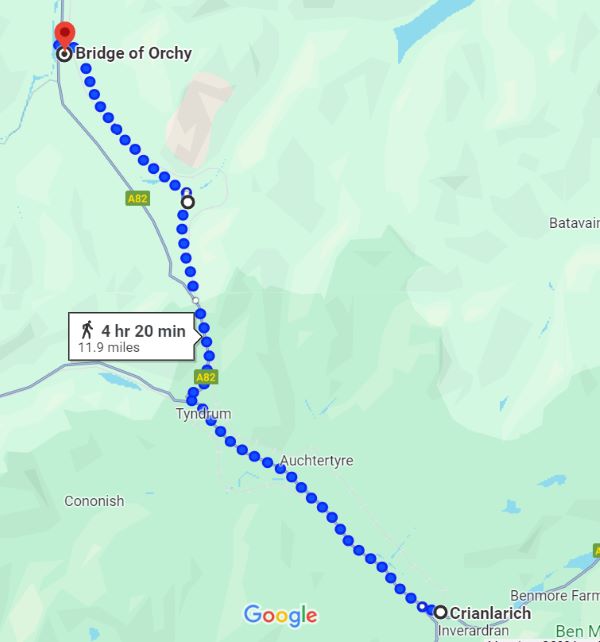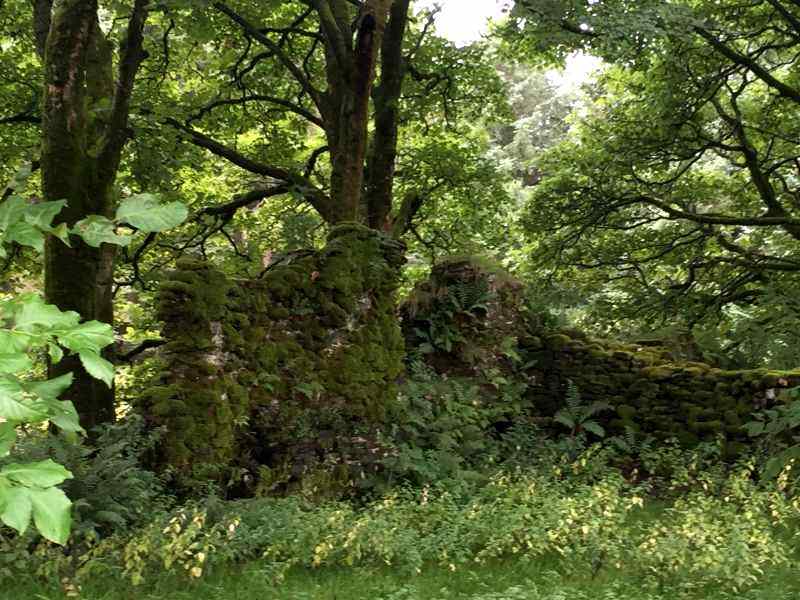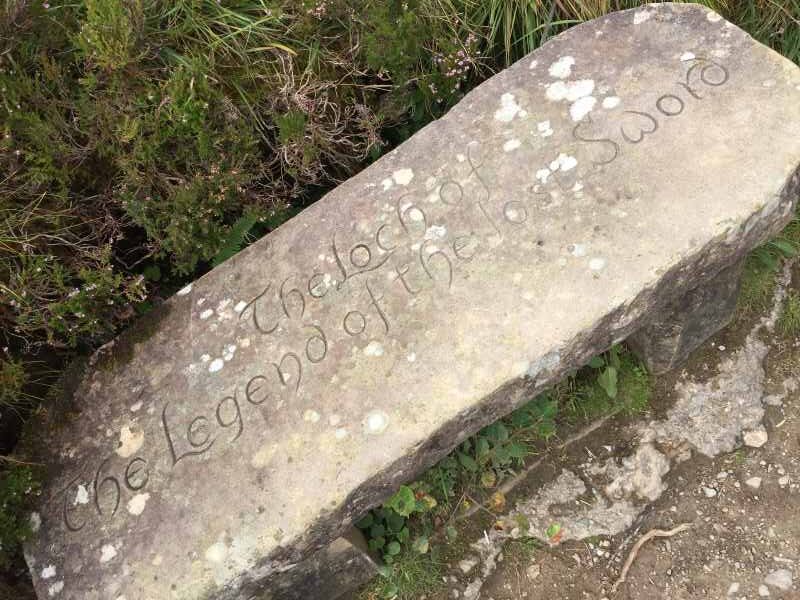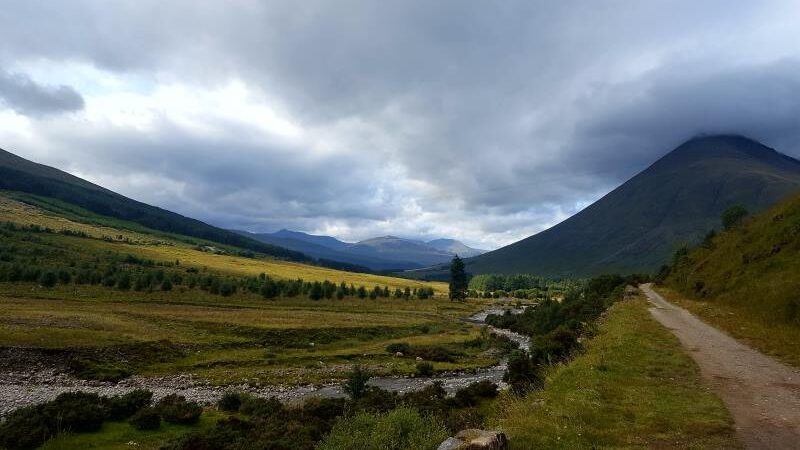Finally, halfway through our West Highland Way hike, I was able to get a good night’s sleep. The lovely Craigbank Guest House in Crianlarich had an excellent cooked breakfast for us in the morning (what luxury). We were on our way by 10am. I felt sorry to be leaving the soft fluffy bed and warm hospitality behind, for sure. The plan for today was to walk to Bridge of Orchy, circa 12 miles or 20 kilometres.

We had no accommodation booked in the small village of Bridge of Orchy as we had originally planned to set up on the permitted wild camping spot by the river. However, by now I had completely given up on sleeping in my tent for the rest of our West Highland Way hike. I had actually thought of disposing of the tent altogether not having to carry it any further. But I decided to keep it just in case of an emergency when we could not find accommodation with a roof. After all, the tent was very light.
No surprise then that before we set off from the Crianlarich guest house, I had looked up accommodation options. The Bridge of Orchy Hotel did not have availability but I was able to book a bed in the West Highland Way Sleeper. It looked super quirky as it is a hostel on a working railway platform. I was looking forward to checking it out.
From Crianlarich to Tyndrum
As we set out from Crianlarich, we turned our backs on the towering majestic peaks of Ben More and Stob Binnein. Jane had bought a brace for her knee in the village pharmacy, but it was still giving her trouble. I worried again that she might need to finish the trail and travel back to Glasgow, change her flight and head back home early. She really did not want to give up and decided to walk for another day and see how she got on. The trail to Tyndrum was stunning, winding through the rugged beauty of the Scottish Highlands dotted with places of historical interest.
St Fillan’s Priory
Fairly soon after Crianlarich we came upon St Fillan’s Priory. The information board told us that St Fillan, like us, was an Irish traveller on foot within the Strath between Tyndrum and Killin. He came to the area to spread the teachings of a Christian way of life to the Scots and to the Picts. After he travelled from Ireland with his mother and uncle, he settled here while they moved to other parts of the country.
The ruin that hikers see today is the remains of the priory built in recognition of Fillan’s teachings, for which he was canonised following his death. Dating from the 13th century, Robert de Bruce endowed the priory in 1317. This monastic community was clearly very important at the time. The priory itself must have been a magnificent building, as it was over 50 metres long. The foundations stretch beneath today’s tarmac road and towards the farm buildings you can see.
A number of holy relics related to St Fillan. They were kept by hereditary guardians known as Dewars. But some of the relics were lost forever after the Dissolution of the Monastery in 1607. Two survived and are now in the National Museum of Scotland in Edinburgh – the Quigrich (staff) and Bernane Bell. The graveyard by the priory ruins dates back to the beginnings of the early Celtic church in the 8th century. In the 1870’s, a new one was opened up further up the hill.


Walking On My Own
After we had explored the Priory for a while, Jane sent me to walk on ahead. Her knee kept giving her trouble and it was tiring for me to stop every so often and to walk at her understandably slow pace. We agreed to meet in The Tyndrum Inn around lunchtime, whenever she would be able to get there. I would be waiting for her with my kindle and a cup of tea. We would then hatch a plan for the rest of the day depending on how she felt. So I went on ahead making good progress. In fact, once I got used to it, I enjoyed being on my own on the beautiful trail.
The Battle of Dalrigh
A short hike from St Fillan’s Priory is the site of the 1306 Battle of Dalrigh. From the info sign here I learnt that the English translation of the Gaelic Dal Righ is ‘place of the King’. This spot has almost 800 years of history. Clan MacDougall and Robert de Bruce were allies during the Wars of Independence in 1296. However, they became enemies when Robert de Bruce murdered the nephew of the clan chief (who was also in line for the throne). The MacDougalls then allied themselves with Edward I of England.
After Robert de Bruce’s defeat in a battle near Perth, Clan MacDougall ambushed the remnants of his army here at Dalrigh. De Bruce’s men were caught by surprise. The battle was apparently a short, frantic one, with the last of de Bruce’s horsemen killed and some of his key allies injured. During the battle, the MacDougalls took the Brooch of Lorn from De Bruce. Afterwards, the Scottish king went into hiding. But two years later, in 1308, he got his own back when he defeated the MacDougalls at the Battle of the Pass of Brander.
The Lochan Of The Lost Sword
Shortly after the Dalrigh battle site I came upon another historic spot: The Loch Of The Legend Of The Lost Sword. Following Robert De Bruce after his loss at Dalrigh, apparently in order to escape more swiftly from the battle, his army threw their heavy weapons into this small lochan. This included De Bruce’s long-sword, Claymore. The Claymore comes from the Gaelic ‘claidheamh-mor’ meaning ‘great sword’. Local legend suggests that it lies here to this day.
The info board, however, says that in reality the real place of the weapons dump is south of this spot, where there is a small loch called Lochan nan Arm. Noone really knows why the legend was moved. Interestingly, in July 2015, a team from MacDonald Armouries in Edinburgh came here to metal detect the site and local lochans. Sadly, they did not find any real evidence either for the battle or dumped weapons. So who knows what really happened or not.

From the Lochan to Tyndrum
I rested on a stone bench by the loch for a while admiring the views and Jane came up behind me. Her knee was much better which was great news. We walked into Tyndrum together, passing a really pretty campsite. We saw two people in the river mining for gold. It seems there is a bit of a gold rush in Tyndrum at the moment! We wished them luck and carried on into the pub.
We stayed in The Tyndrum Inn for a good while. Jane felt she definitely could finish the hike. I was glad I would not have to be on my own for the final few days. During lunch, I rebooked our camping in Glencoe from a tent pitch to a microlodge. I also sent an enquiry about accommodation in Kinlochleven. I felt I needed to find somewhere to stay before we got there.
From Tyndrum To Bridge Of Orchy
From Tyndrum it was a really lovely walk to our today’s destination, Bridge of Orchy. Now the scenery is becoming very picturesque. Vey what you imagine to be Scottish Highlands-like. We had great weather all day, giving us some incredible views across the bens and glens. We got to Bridge of Orchy around half past six, which was not too bad going. My accommodation, the West Highland Way Sleeper, is on a working railway platform. I got a bed on a top bunk. It was warm but also very bright as the platform lights were on throughout the night. Quirky or what. I had a shower which felt really great and I charged my phone, too!
I then walked down to the wild camping spot by the river where Jane pitched her tent. What a spectacular view over the surrounding majestic hills! You really feel the tranquillity of this remote place. We had dinner and two glasses of wine in the Bridge Of Orchy Hotel, halfway between the Sleeper and the campsite and then went to sleep. I read a little of my book before turning in. It was a great day.

